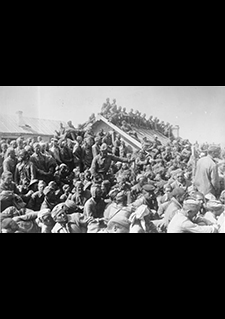War of Extermination against the Soviet Union
The attack on the Soviet Union on June 22, 1941 endowed the European revanchist war with a new character. It became a war of race and extermination conducted with utmost brutality, which was intended to systematically plunder the captured territories at the expense of the inhabitants.
At first, the German Wehrmacht was able to bring many territories in the Soviet Union swiftly under their control and occupy them. The front ceased advancing for the first time with the onset of winter in 1941. The Germans saw themselves confronted with a massive Soviet counteroffensive. Although the Wehrmacht managed to capture territory once again in the summer of 1942, the Germans were forced to begin their retreat westward that very same year.
The disastrous defeat at Stalingrad, where around 150,000 German soldiers were killed in action or froze or starved to death in the winter of 1942-43, came to symbolize the turning point of the war. The Soviets took approximately 91,000 soldiers prisoner, of which only around 6,000 survivors returned to Germany. Militarily, Stalingrad was crushing defeat in the war against the Soviet Union, which could no longer be concealed, and a reversal in the war in the East. From then on, the Soviet’s conduct dictated the further course of the war.
The boundaries between the persecution of civilians and acts of war were blurred in the “war of ideology” against the Soviet Union. The Wehrmacht and SS Einsatzgruppen in the rear areas conducted not only a battle against a military enemies but simultaneously also a war to systematically displace and exterminate the civilian population. Initial plans to supply German soldiers knowingly accepted the starvation of millions of civilians in the Soviet Union. Under the pretext of “anti-partisan warfare”, German Einsatzgruppen took systematic action as killing squads against the local civilian population. Soviet civilians were carried off as forced labor.
The war exacted tremendous casualties among German soldiers, too. The number of families that mourned one or more members rose dramatically. Death and mourning made their presence felt significantly more than in the months of the “blitzkriegs”.

